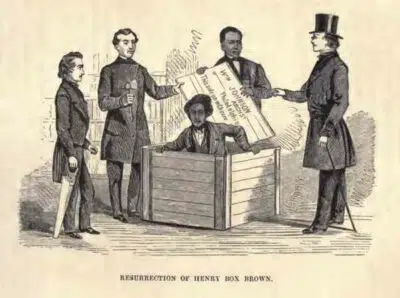When Harry Box Brown was shipped in the box, he almost died. He said he “was resolved to conquer or die,” even as “I felt my eyes swelling as if they would burst from their sockets; and the veins on my temples were dreadfully distended with pressure of blood upon my head.”
In Richmond about 1836, Henry Brown married Nancy, a slave owned by a different master, and together they had three children. The family joined the First African Baptist Church, where Henry Brown sang in the church’s choir. He had become a skilled tobacco worker and earned enough money through overwork to set up his family in a rented house.
Then, in August 1848, Nancy Brown’s master sold her and their three children to another master in North Carolina. At the time, she was pregnant with a fourth child.
He mourned for months but then decided he would escape slavery. One of the men in the choir, James Caesar Anthony Smith, a free black, helped him with his plan. He hired a white shoemaker names Samuel Alexander Smith, a slave owner himself, to help Brown escape. He had ties to the Underground Railroad.
Brown had the inspiration to be shipped in a box by rail to Philadelphia.
On March 23, 1849, the Smiths sealed Brown into a wooden box three feet long, two and one-half feet deep, and two feet wide, and conveyed the package as “dry goods” from Richmond to Philadelphia.
On the steamboat transfer up the Potomac River to Washington from the Richmond, Fredericksburg, and Potomac Railroad‘s terminus at Aquia Creek, Brown was turned head down in the box for several hours and nearly died. At other transfers the box was tossed and slammed to the ground. He later wrote that he “was resolved to conquer or die,” even as “I felt my eyes swelling as if they would burst from their sockets; and the veins on my temples were dreadfully distended with pressure of blood upon my head.”
Even as he thought he might die, Brown heard a man telling another that he had been standing too long and needed a place to sit; “so perceiving my box, standing on end, he threw it down and then two sat upon it. I was thus relieved from a state of agony which may be more easily imagined than described.”
After 26 hours, the small box was opened upon arrival in Pennsylvania at the office of the Anti-Slavery Society.
Brown emerged, alive and free. “I had risen as it were from the dead,” Brown wrote.
At the end of May Brown appeared before the New England Anti-Slavery Convention in Boston, and his daring escape was regaled. At the time slave owners said the slaves didn’t want their freedom. Henry put that lie to bed.
His name was changed from Henry Brown to Henry Box Brown. A song was written about him and his exploit and in 1849, Charles Stearns published the Narrative of Henry Box Brown. Brown and Stearns toured New England giving lectures and selling the book.
Samuel Smith attempted another shipment of slaves from Richmond to Philadelphia on May 8, 1849, but was discovered and arrested. That November he was sentenced to six and one-half years in the state penitentiary. James C. A. Smith had aided Smith in the attempt but avoided arrest until September 25, 1849. A divided panel of magistrates enabled him to escape conviction. James C. A. Smith had joined Brown in Boston by December.
On August 30, 1850, with passage of the Fugitive Slave Bill imminent, Brown was assaulted on the street in Providence, Rhode Island. Believing himself at risk of being captured and returned to Virginia under the law, Brown, along with Smith, sailed to England in October 1850. They continued the exhibitions.
In June 1851 Brown’s and Smith’s partnership ended after a bitter dispute involving money and Smith’s complaint that Brown had made no effort to purchase his own family.
We don’t know why he didn’t. Details will forever remain a mystery.
Brown left the abolitionist circuit and got into English show business, remarried a woman in show business, and took to hypnotizing audiences as a mesmerist.
In 1875, accompanied by his wife and daughter Annie, Brown returned to the United States. Billing himself as “Prof. H. Box Brown,” he performed as a magician.
Research done by the scholar Martha J. Cutter has shown that by that time Henry Box Brown was living in Toronto, where he died on June 15, 1897. He was buried in Necropolis Cemetery there.
More than a century later, the man who escaped slavery in a box has become a symbol of the Underground Railroad, and his confinement and triumphant emergence from the box have inspired works by several contemporary artists.





Because freedom is life itself and those who seek to extinguish freedom are out to extinguish life. “Don’t be scared, quit your sniveling.” Bad Boy Club, 1986. O/T-Woohah! Fahrvergnügen Road Snake moves with cutting off about five cars at the roundabout and passing up some replacement Amazon driver with hazards on holding up the entire road, Petey Butt can go… Read more »